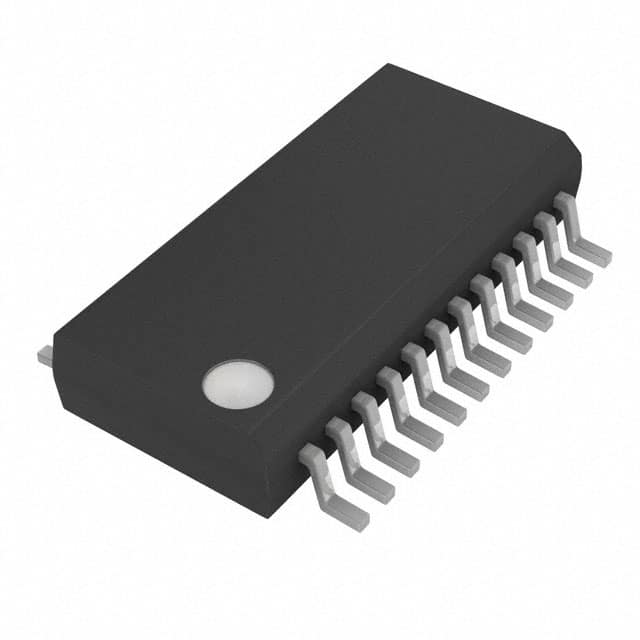PCF8575CDBQR
Product Overview
- Category: Integrated Circuit (IC)
- Use: I/O Expander
- Characteristics: High-speed, 16-bit remote I/O expander for I2C-bus applications
- Package: SSOP (Shrink Small Outline Package)
- Essence: The PCF8575CDBQR is a versatile I/O expander that allows the user to increase the number of I/O ports available in their system.
- Packaging/Quantity: Tape and Reel, 2500 units per reel
Specifications
- Supply Voltage: 2.3V to 5.5V
- I/O Ports: 16
- I2C-bus Interface: Compatible with I2C-bus Fast-mode and Standard-mode
- Operating Temperature Range: -40°C to +85°C
- Maximum Frequency: 400 kHz
Detailed Pin Configuration
The PCF8575CDBQR has a total of 24 pins. The pin configuration is as follows:
- SDA (Serial Data Line)
- SCL (Serial Clock Line)
- A0 (Address Input Bit 0)
- A1 (Address Input Bit 1)
- A2 (Address Input Bit 2)
- GND (Ground)
- P7 (I/O Port 7)
- P6 (I/O Port 6)
- P5 (I/O Port 5)
- P4 (I/O Port 4)
- P3 (I/O Port 3)
- P2 (I/O Port 2)
- P1 (I/O Port 1)
- P0 (I/O Port 0)
- VDD (Supply Voltage)
- INT (Interrupt Output)
- NC (No Connection)
- NC (No Connection)
- NC (No Connection)
- NC (No Connection)
- NC (No Connection)
- NC (No Connection)
- NC (No Connection)
- NC (No Connection)
Functional Features
- High-speed I2C-bus interface allows for fast communication with the host microcontroller.
- 16-bit remote I/O expander provides additional I/O ports for the system.
- Bidirectional I/O ports can be individually configured as inputs or outputs.
- Interrupt output pin alerts the microcontroller when a change in input status occurs.
Advantages and Disadvantages
Advantages: - Increases the number of available I/O ports in a system. - Versatile and flexible for various applications. - Compatible with standard I2C-bus interface. - Low power consumption.
Disadvantages: - Limited to 16 I/O ports, may not be sufficient for complex systems requiring more I/Os. - Requires additional programming and configuration to utilize its full potential.
Working Principles
The PCF8575CDBQR operates by communicating with the host microcontroller through the I2C-bus interface. The microcontroller sends commands and data to the PCF8575CDBQR, which then controls the I/O ports accordingly. The bidirectional I/O ports can be individually configured as inputs or outputs, allowing for versatile usage in various applications.
Detailed Application Field Plans
The PCF8575CDBQR is widely used in applications that require an expansion of I/O ports. Some common application fields include:
- Industrial Automation: Used to control and monitor multiple sensors, actuators, and devices in industrial automation systems.
- Home Automation: Enables the connection and control of various home appliances and devices, such as lighting systems, security systems, and smart home devices.
- Automotive Electronics: Integrated into automotive electronic systems to expand the number of I/O ports for controlling various functions, such as lighting, climate control, and infotainment systems.
- Robotics: Utilized in robotics applications to interface with multiple sensors, motors, and other peripherals.
- IoT (Internet of Things): Integrated into IoT devices to provide additional I/O ports for connecting and controlling various sensors and actuators.
Detailed and Complete Alternative Models
- MCP23017: 16-bit I/O expander with I2C-bus interface.
- MAX7313: 16-bit I/O expander with serial interface.
- PCA9538: 8-bit I/O expander with I2C-bus interface.
- TCA6424A: 24-bit I/O expander with I2C-bus interface.
- SX1509: 16-channel GPIO expander with I2C-bus/SMBus interface.
These alternative models offer similar functionality and can be used as substitutes for the PCF8575CDBQR depending on specific requirements and compatibility with the system.
In conclusion, the PCF8575CDBQR is a high-speed, 16-bit
技術ソリューションにおける PCF8575CDBQR の適用に関連する 10 件の一般的な質問と回答をリストします。
Sure! Here are 10 common questions and answers related to the application of PCF8575CDBQR:
Q: What is PCF8575CDBQR? A: PCF8575CDBQR is an I/O expander integrated circuit (IC) that provides additional input/output pins for microcontrollers or other digital devices.
Q: How many I/O pins does PCF8575CDBQR have? A: PCF8575CDBQR has a total of 16 I/O pins, which can be configured as either inputs or outputs.
Q: What is the voltage range supported by PCF8575CDBQR? A: PCF8575CDBQR supports a voltage range of 2.3V to 5.5V, making it compatible with a wide range of microcontrollers and digital devices.
Q: Can PCF8575CDBQR handle both analog and digital signals? A: No, PCF8575CDBQR is designed to handle only digital signals. It cannot process analog signals directly.
Q: How do I communicate with PCF8575CDBQR? A: PCF8575CDBQR uses the I2C communication protocol, so you need to connect it to your microcontroller using the SDA (data) and SCL (clock) lines.
Q: Can I use multiple PCF8575CDBQR ICs in my project? A: Yes, you can use multiple PCF8575CDBQR ICs in your project by assigning unique I2C addresses to each IC. The IC supports up to 8 different addresses.
Q: What is the maximum current that PCF8575CDBQR can source or sink? A: PCF8575CDBQR can source or sink up to 25mA per I/O pin, with a total package current limit of 400mA.
Q: Can PCF8575CDBQR handle interrupts? A: Yes, PCF8575CDBQR supports interrupt functionality, allowing your microcontroller to be notified when an input pin changes its state.
Q: Is PCF8575CDBQR compatible with 3.3V microcontrollers? A: Yes, PCF8575CDBQR is compatible with both 3.3V and 5V microcontrollers, as it operates within the voltage range supported by most microcontrollers.
Q: What are some common applications of PCF8575CDBQR? A: PCF8575CDBQR is commonly used in applications that require additional digital I/O pins, such as industrial automation, robotics, home automation, and sensor interfacing.
Please note that these answers are general and may vary depending on specific implementation details and requirements.


